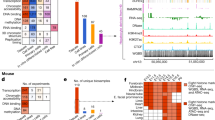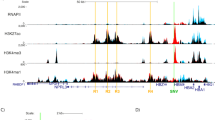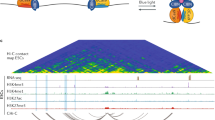Abstract
ERF (Ets2 Repressor Factor) is a ubiquitously expressed ets-domain protein that exhibits strong transcriptional repressor activity, has been shown to suppress ets-induced transformation and has been suggested to be regulated by MAPK phosphorylation. We report here the sequence of the mouse gene, the genomic organization of the human and the mouse genes, their chromosomal position and the analysis of the promoter region. Genomic clones encompassing either the human ERF or the mouse Erf gene were isolated and utilized to define their molecular organization. The gene in both species consists of 4 exons over a 10 kb region. Utilizing FISH, somatic cell hybrids and linkage analysis, we identified the chromosomal position of ERF on human chromosome 19q13.1 and on its syntenic region in the mouse, on chromosome 7. Sequence analysis of the mouse gene indicated a 90% identity to the human gene within the coding and promoter regions. The predicted Erf protein is 98% identical to the human protein and all of the identifiable motifs are conserved between the two proteins. However, the mouse protein is three amino acids longer (551 versus 548 aa). The area surrounding the region that is homologous to the 5′ end of the human cDNA can serve as a promoter in transfection into eukaryotic cells. This region is highly conserved between the mouse and the human genes. A number of conserved transcription factor binding sites can be identified in the region including an ets binding site (EBS). Interestingly, removal of a small segment that includes the EBS, seriously hampers promoter function, suggesting the ERF transcription may be regulated by ets-domain proteins.
This is a preview of subscription content, access via your institution
Access options
Subscribe to this journal
Receive 50 print issues and online access
$259.00 per year
only $5.18 per issue
Buy this article
- Purchase on Springer Link
- Instant access to full article PDF
Prices may be subject to local taxes which are calculated during checkout
Similar content being viewed by others
Author information
Authors and Affiliations
Rights and permissions
About this article
Cite this article
Liu, D., Pavlopoulos, E., Modi, W. et al. ERF: Genomic organization, chromosomal localization and promoter analysis of the human and mouse genes. Oncogene 14, 1445–1451 (1997). https://doi.org/10.1038/sj.onc.1200965
Received:
Revised:
Accepted:
Issue Date:
DOI: https://doi.org/10.1038/sj.onc.1200965
Keywords
This article is cited by
-
Ets target genes: past, present and future
Oncogene (2000)
-
Exon 4-encoded acidic domain in the epithelium-restricted Ets factor, ESX, confers potent transactivating capacity and binds to TATA-binding protein (TBP)
Oncogene (1999)
-
Characterization of the human and mouse ETV1/ER81 transcription factor genes: role of the two alternatively spliced isoforms in the human
Oncogene (1999)



